Fine Dust Masks In Korea – Do You Need One?
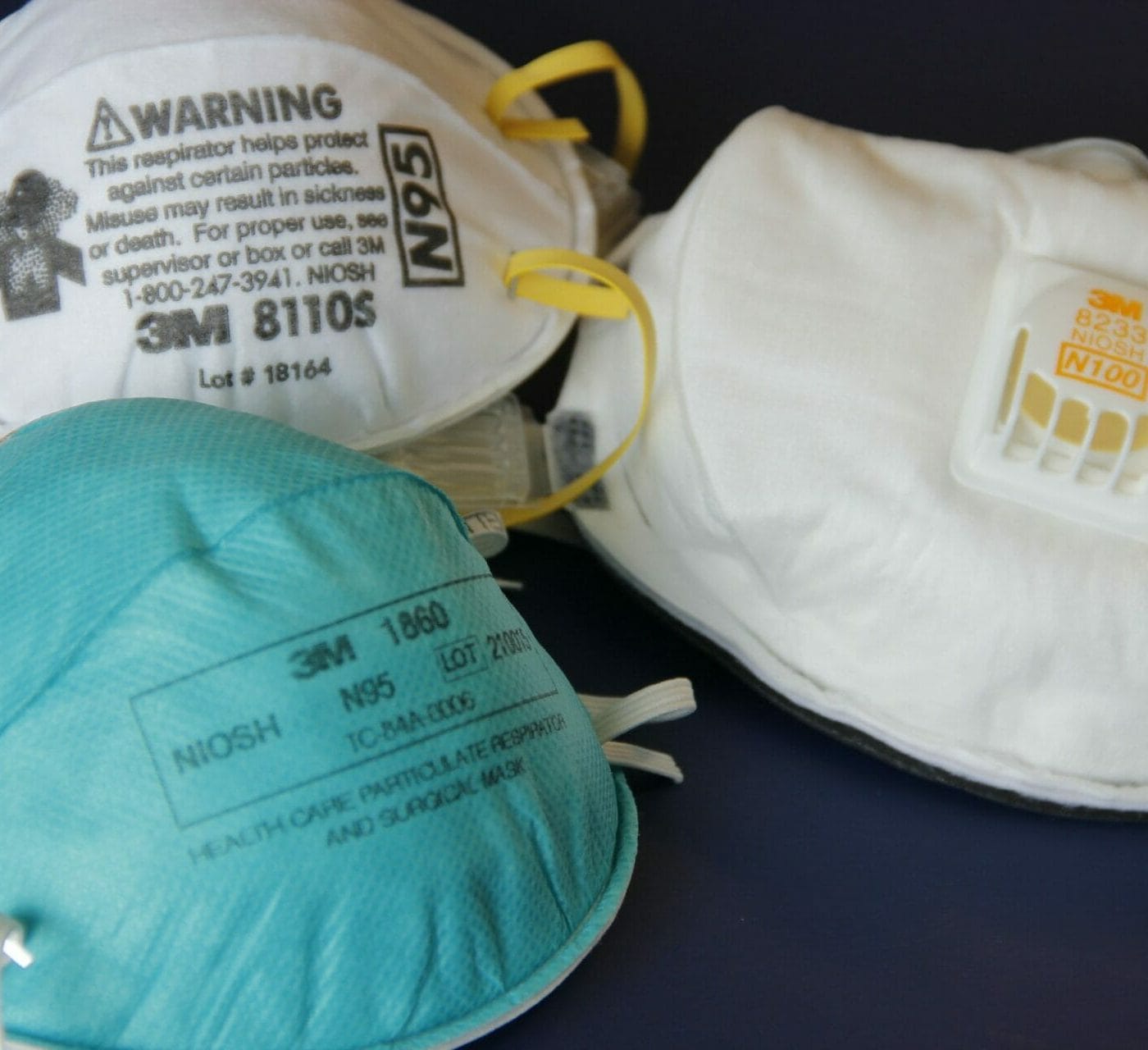
The wrong fine dust mask, or one worn incorrectly, will not protect you at all. Every day I see people wearing masks incorrectly and often wearing the wrong masks altogether.
The false security that these masks provide is incredibly dangerous when considering that air pollution is now the leading cause of deaths worldwide.¹
I recently published an article discussing the air quality in Korea and how to deal with it. After sharing the post on Facebook, a lot of people disagreed about the usage period of disposable masks.
Many people said that they use them for a few days in a row and that they are still effective after a few days of heavy pollution.
I realized that there is a lot of confusion out there as to how specifically these masks work, and I want to discuss which masks are the best, how long they last, and more, in this post.
Which masks actually protect you from fine dust, how long do they last, and how should they be correctly worn? What is the best fine dust mask?
Disclaimer: I am not a doctor or expert in the field of air pollution/fine dust. However, this article is the result of many hours of research from many official information sources around the internet. All sources are included at the end of the post – please feel free to refer to them for more information.
This site contains affiliate links to products. I may receive a commission for purchases made through these links. Affiliate Disclaimer.
What is Fine Dust?
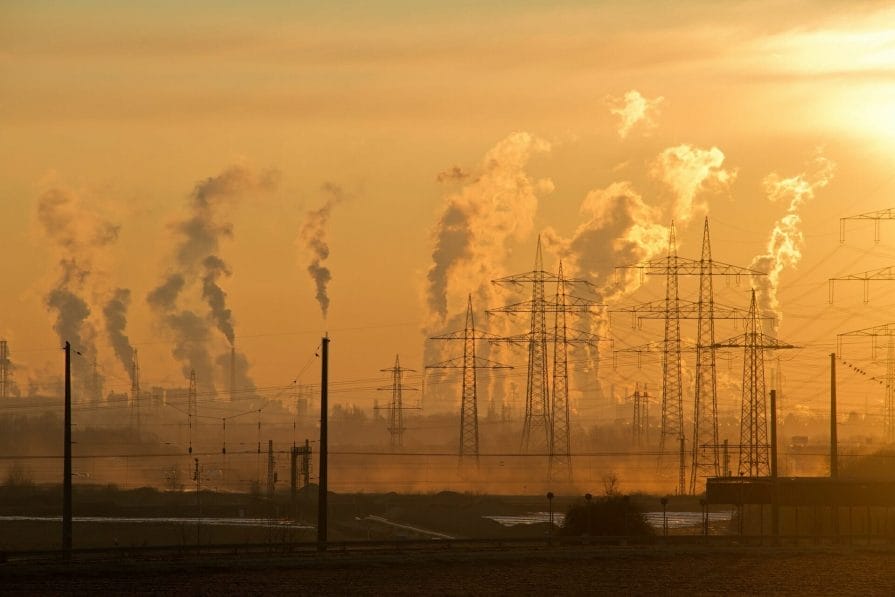
Fine dust contains small particles, many of which are emitted by factories.
Fine Dust is made up of millions upon millions of tiny particles in the air. These particles vary in size but are generally categorised as PM2.5 and PM10. The number relates to the size of the particle – PM10 are particles under 10 microns in size, meanwhile, PM2.5 are particles under 2.5 microns in size.²
While both of these are dangerous, PM2.5 has more harmful long-term effects due to the smaller size of the particles. The smaller particles are also harder to filter out and protect your body from.
This post is primarily about fine dust masks. Learn more about fine dust in Seoul (including how to understand AQI, health dangers, and the causes).
Fine dust also goes by many other names. You may hear it referred to as particulate matter, ultra fine particles, or other similar names.
Fine Dust or Yellow Dust?

Although this article is focused on masks, it is worth mentioning the difference between fine dust and yellow dust to avoid future confusion.
Fine dust is the aforementioned small dust particles that are found in the air. Yellow Dust (also called Asian Dust), on the other hand, is a specific type of dust that comes from the deserts of China, Mongolia, and Kazakhstan. More recently, this dust also contains the particle emissions of many factories in these countries – especially China.³
This dust is weather dependent and only reaches South Korea under certain wind conditions. This is the dust that is very prevalent in the spring months (March-May). Dust in the other months is usually NOT Yellow Dust, but rather domestically produced fine-dust.
That is to say – Yellow Dust is a specific type of fine dust that occurs in Korea (primarily) in spring. However, Yellow Dust and fine dust are not the same things.
Purchase fine dust masks | Gearbest (KN95) | Ebay | Coupang
Why Should You Care?
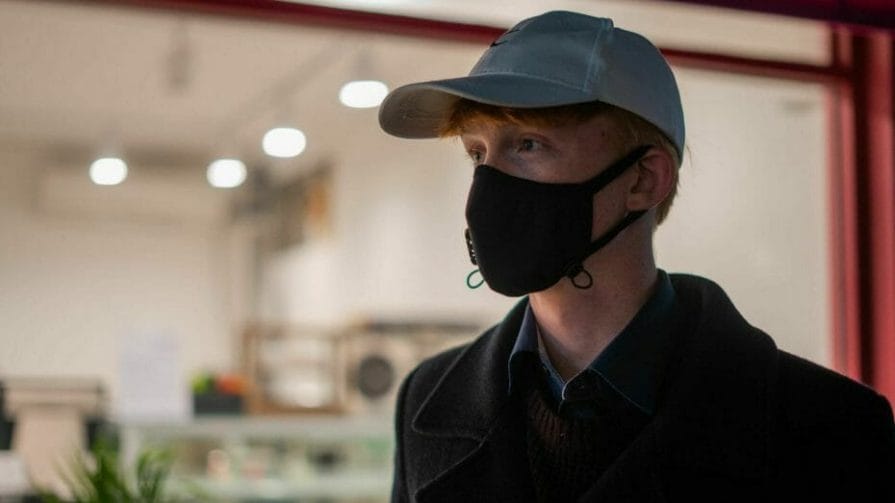
I often get asked – why do you wear a mask? Especially by other foreigners in Korea. The dust is such a common occurrence that most people tend to just overlook it.
I believe that this is for two reasons – a lack of resources (in English) that explain the dangers, and because it is a long term health hazard. The impacts of air pollution will not be noticeable instantly. Or in a month. Or possibly even in a year.
Because of this, it’s often forgotten or just overlooked. However, it really shouldn’t be. It is, quite literally, the most dangerous thing in the world.
I don’t want to fear-monger here, but let me list some recent research findings:
- More deaths occur every year from air pollution than the combined total of war, murder, tuberculosis, HIV, AIDs and malaria.¹
- Air pollution was recently found to have effects on every organ on the body. Further than this, it has been found to affect virtually every cell in the human body.⁴
- In another recent study, air pollution has been linked to bipolar disorder, depression⁵ and even suicide.⁶
I can’t emphasise this enough – air pollution will kill.
With that being said, air pollution dangers can be minimised. Learn more about air pollution in Seoul, including the causes, health effects, and how to understand AQI.
If you are in Korea for a week, month, or a year, you need to consider ways to minimise the damages of air pollution. The first step for doing that is to get the right fine dust mask.
Want to learn more about air pollution and its other impacts? Learn more at Breathe Safe Air.
How to Check Air Quality
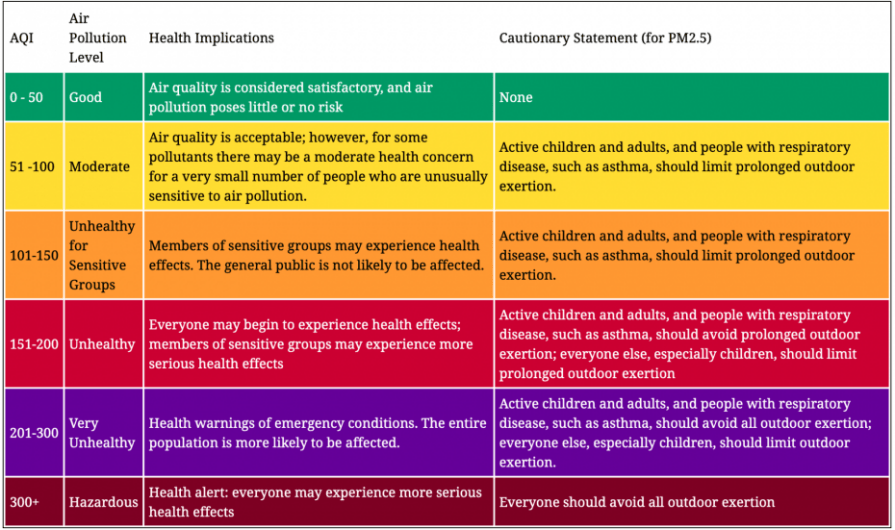
AQICN is the best resource to check air quality.
The AQI (Air Quality Index) is best checked using aqicn.org. While there are many different platforms out there that report on air quality, this website provides the most detailed breakdown on not only particulate matter but also on gases in the air. If you are looking for a mobile app, then I recommend Air Quality. It is the most widely used and trusted app.
Both of these platforms are updated regularly and will provide the latest air quality updates. The app is especially helpful as you can set up alert notifications on your phone. There are also many more options for anyone interested. Don’t know how to understand AQI readings? Learn more about understanding AQI.
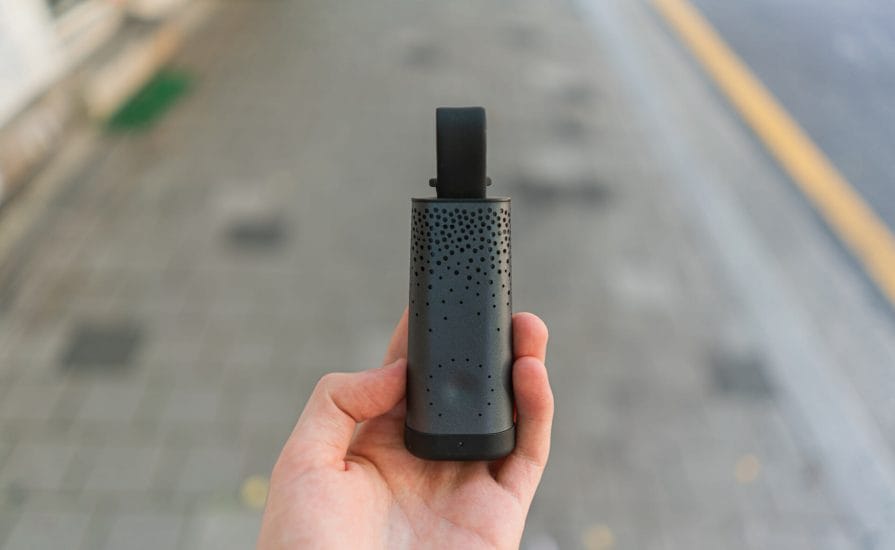
If you are interested in measuring air quality on a more personal level, then there are a few devices on the market that will allow you to do so. One portable air pollution monitor that I recently reviewed is Flow 2 by Plume Labs.
This device will allow you to monitor the air pollution in your vicinity and for that reason, is more accurate in monitoring the air that you are actually breathing (rather than the air in a district or the city as a whole).
If you are interested in such a device I recommend checking out their store – they recently started selling the device in Korea.
Best Fine Dust Masks in Korea
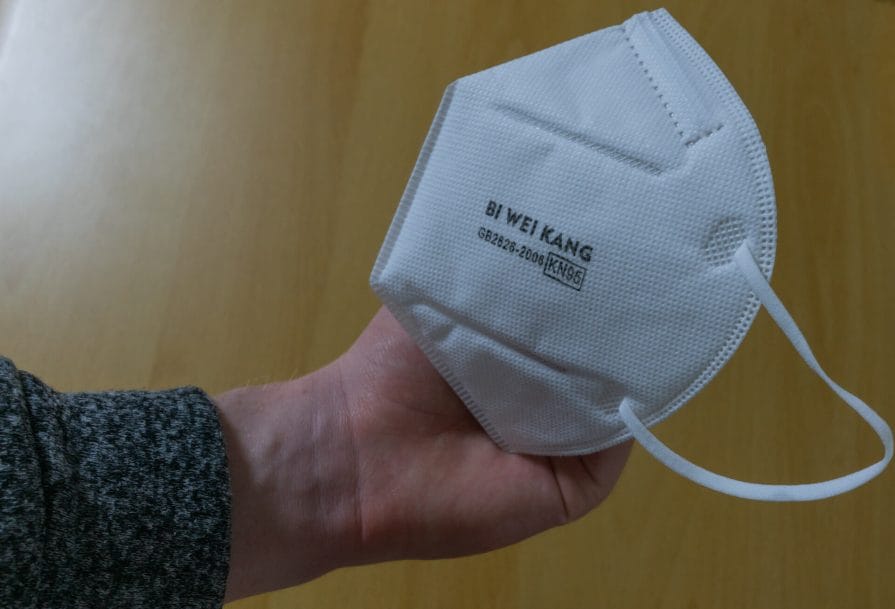
KN95 Respirator from China.
For the best protection look for N95+ and KF94 masks. To learn more about these ratings and what they mean, continue reading.
For the best convenience, I have also made an Amazon list which can be found here. This list includes a variety of different masks that will protect you from fine dust. If all of the respirators are sold out, consider checking out Gearbest.
When it comes to disposable fine dust masks in Korea there are hundreds if not thousands of options and all of them will perform slightly differently. However, any mask over N95 or KF94 should be effective at filtering 95% (or 94%) of fine dust particles.
Personally, I recommend getting a reusable mask. These are far more convenient, often more comfortable, and also cheaper over the long run. Below I have included a list of some of the most popular reusable masks that offer high filtration of fine dust particles:
Of course, there are many more masks than those listed above. However, it’s impossible to list all of the masks here. I have tried all of the above masks and reviewed them on my other website, Breathesafeair. If you are interested in reading more about reusable masks please feel free to visit.
Fine Dust Masks for Children

Protection for children is also important. Please keep in mind that these are cloth masks, not respirators.
There are fine dust masks available for children. However, they are very rarely as effective as those for adults. If a mask doesn’t create a proper seal on your face, the effectiveness is significantly less. Even adult’s masks rarely fit perfectly.
Due to the large variation in children’s face sizes, and due to the fact that children tend to move a lot, it’s very hard to keep a mask well fitted. On top of this, children also tend to touch their mask, which is something that can decrease the effectiveness.
There are some children’s masks available. However, make sure that you are aware that they have very limited effectiveness.
Another factor worth noting is that it is far harder to find highly rated masks for children. In Korea, children’s masks tend to be KF80 where most adult’s masks are usually KF94.
Children’s mask options – KN95 Children’s Mask | KF94 Children’s Mask | Other children’s KF94 Masks
Surgical Masks
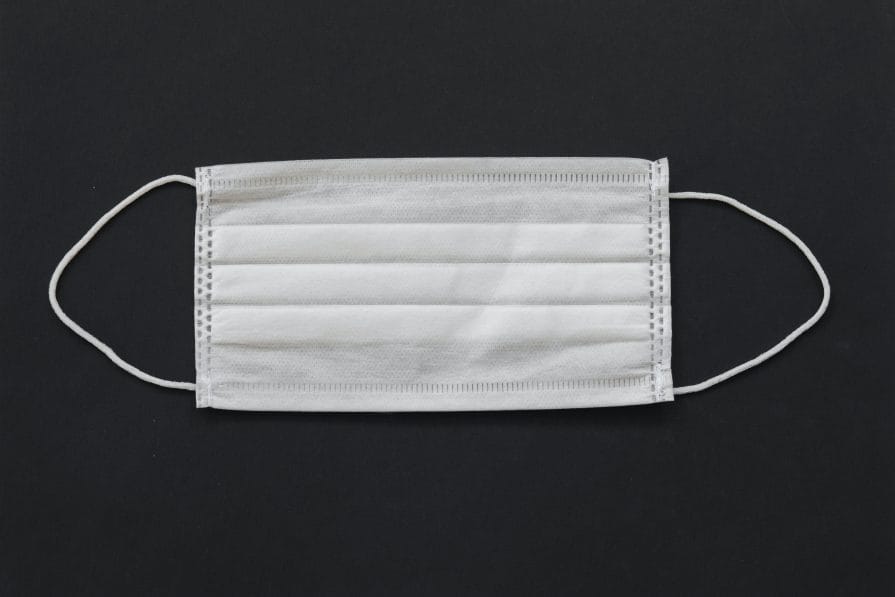
Surgical masks will NOT protect you from fine dust.
Surgical masks are one of the most common mask types that I see people wearing every day. Many people wear these to protect both themselves and others from sickness, but, there are also many who wear them with the assumption that they protect from fine dust.
This is not only untrue but something that is potentially harmful to assume. Surgical masks have two straps that sit behind your ears, and these are ineffective against fine dust for a number of reasons.
Not only is the material not meant to prevent the penetration of fine dust, but the masks also don’t create a seal on the wearers face. Fine dust can simply enter the mask through the gaps around the wearers face.
The masks are made to block bodily fluids from the wearer as stated by the quote below:
‘Common surgical masks are meant to catch the wearer’s own bodily fluids, such as saliva and nasal discharge, and prevent any infectious liquid droplets from spreading to others. They are not designed to protect you from inhaling airborne bacteria, viruses and fine particles.’⁷
These masks are called surgical masks as they are most often worn in surgery. They are generally worn to prevent fluids if the wearer is sick, or (in Korea), by people who don’t want to be in public without make-up.
Dust Masks

Despite what the name may lead you to believe, dust masks are NOT meant to protect you from fine dust. Dust masks technically are masks that are meant to prevent non-toxic nuisance dust in occasional activities such as mowing the lawn or sweeping.
‘Dust masks are not NIOSH approved disposable filtering facepieces. They can be worn for comfort against non-toxic nuisance dust during activities like mowing, gardening, sweeping and dusting. These masks are not respirators and do not offer protection against hazardous dust, gases or vapours’.⁸
Simply put, a dust mask will usually look like a respirator but will not have a NIOSH or KFDA rating (N or KF rating). These masks will NOT protect you from fine dust.
Respirators

Respirators, on the other hand, are masks meant to prevent fine particles from entering the body of the user. These respirators are rated N95+ (with the number representing the percentage of particles prevented by the mask. I.E, an N95 mask is effective at preventing 95% of particles from passing, while an N99 mask is effective against 99% of fine particulate matter).
NIOSH masks are rated by the National Institute for Occupational Safety and Health – a United States federal agency. Korea, however, also has a rating system which is managed by the KFDA (The Korean Ministry of Food and Drug Safety).
These masks come with KF ratings from KF80 onward. Similar to N rated masks, the KF number represents the percentage of fine dust particles that are blocked by the mask.
R rated masks (R95+) are also available and are resistant to oil. However, these aren’t needed for the general user in Korea. If you bike often on roads (behind other vehicles especially), then consider purchasing R masks to protect from the harmful gasses emitted by the vehicles sharing the road.
It is worth noting, however, that KF and N rated masks only protect you from fine dust. They do not protect from other ozone pollution such as gases.
‘N95 masks do NOT protect you against chemical vapours, gases, carbon monoxide, gasoline, asbestos, lead or low oxygen environments.’⁹ Learn more about the different pollutants in the air.
Purchase fine dust respirators | Gearbest (KN95) | Ebay | Coupang
Convenience Store Masks
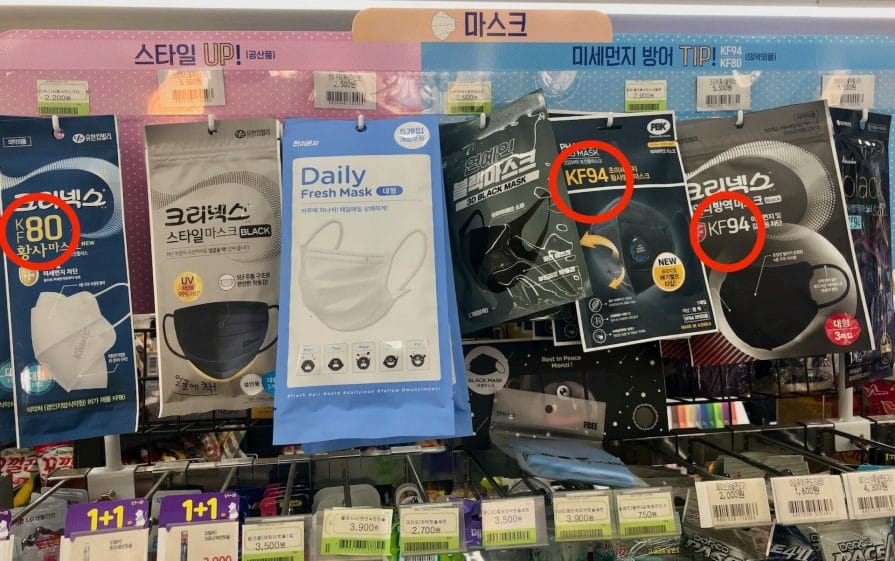
Masks at a Korean convenience store.
It’s all well and good to say which masks are ideal. However, sometimes you just don’t have masks in advance. Sometimes the fine dust seemingly comes out of nowhere and you are out of masks.
If this is the case, don’t worry! Every convenience store and pharmacy in Korea will have a variety of fine dust masks on sale.
Convenience stores will usually have surgical masks, dust masks, and respirators on sale. If you need to purchase a mask from a convenience store then make sure to purchase a mask with either an N or KF rating. N ratings are usually better, however, a respirator with a KF rating will also protect you.
Since the KF rating is easier (and cheaper) to acquire, you are more likely to find KF rated masks. While N rated masks are possible to find locally, you will usually have more difficulty finding them.
Pharmacies tend to have more options, however, they can be harder to find.
No matter what marketing a mask may have, DO NOT purchase it unless it has an N or KF rating. Only purchase KF80 masks if nothing else is available – KF94 is far better.
Disposable VS Reusable Masks
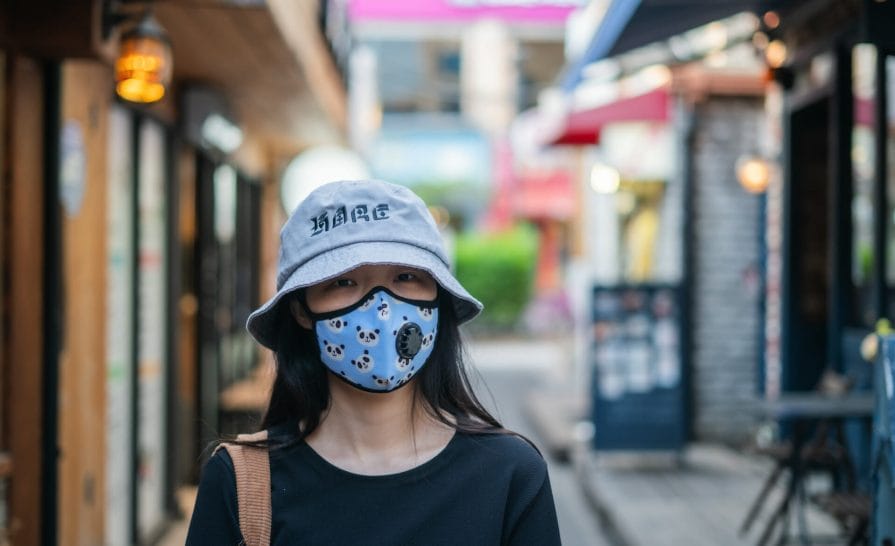
Most masks that you find on sale in stores around Korea will be disposable masks. These masks are only rated for a single use (generally 8 hours), and are not meant to be reusable.
Disposable masks can NOT be washed or cleaned. Once they become difficult to breathe through, they should be disposed of immediately.
Reusable masks, on the other hand, can last up to 300 hours. These masks will be more expensive, but they can be worth the increased cost. Many reusable masks can be washed.
If you care about fashion, then a reusable mask is the way to go. Since they are made to last longer, you can find reusable masks with designs that are ideal for making them a little less ugly.
Here are some reusable masks that might be worth looking into:
Learn more about the best reusable respirators.
How Long Can I Use a Single Use Mask For?
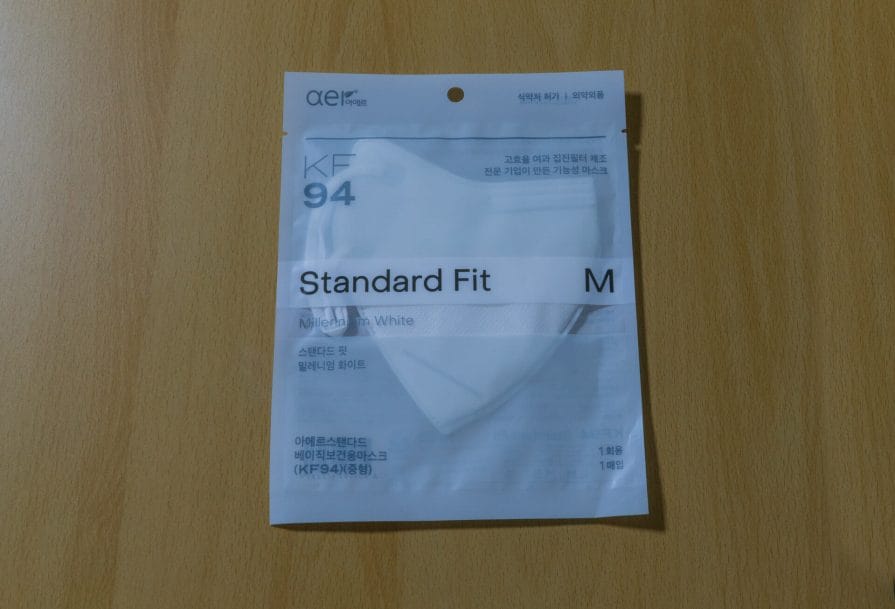
A standard disposable respirator. This one is KF94 rated.
Disposable masks can be used more than once. However, they shouldn’t be worn for more than a few days in heavy pollution.
‘All FDA-cleared N95 respirators are labeled as “single use”, disposable devices. If your respirator is damaged or soiled, or if breathing becomes difficult, you should remove the respirator, discard it properly, and replace it with a new one. To safely discard your N95 respirator, place it in a plastic bag and put it in the trash. Wash your hands after handling the used respirator.’¹⁰
‘However, there are limitations for reuse. Perhaps most importantly, the FFR should be used and reused only by the same wearer. Also, between uses, the FFR should be stored in a way that protects it from damage, dust, contamination, sunlight, extreme temperatures, excessive moisture, and damaging chemicals.
In addition, since most disposable FFRs do not have solid frames, they should be stored in ways that prevent deformation of the face-piece, straps, and exhalation valve, if present.’¹¹
When storing the mask, make sure it isn’t placed in the sun, and that there is nothing around to put pressure on the mask and deform it. Deforming the mask will reduce its effectiveness by decreasing the fit and ruining the seal.
Further, have one mask per person, and don’t share masks. Once worn, the mask is shaped to the face of the wearer. Allowing others to wear the mask will break this shape and will once again, decrease effectiveness.
In short, masks can be used more than once. However, keep these factors in mind when storing your mask:
- Store your mask in a place that is protected. Keep it out of sunlight, and make sure it stays dry. Make sure that it will not be crushed or deformed.
- Do not touch the filter of the mask. If possible, try to only touch the straps.
- Do not share your mask. Get separate masks for every family member.
With the recent shortages of masks, research has been done into the viability of disinfection and reuse. Learn more here.
Factors That Impact Mask Lifespan

The level of pollution is the biggest influence on a mask’s lifespan.
It is also very important to remember that the reusing of masks depends heavily upon a few factors.
Air pollution level, humidity, and amount of physical exertion are three main factors.
- For days of high pollution (such as days with an AQI rating over 250), masks should only be worn for a single day. However, on days of lower AQI ratings (such as 50), these masks can be reused for a few days, until breathing becomes difficult.
- Physical exertion can also vary the lifespan of a respirator, and if you are running or biking with a mask, consider replacing it every day or two – even in days of light pollution.
- Finally, humidity greatly affects the effectiveness of a respirator, as once a mask becomes damp it quickly loses its filtration qualities. On high-humidity days, change your respirator every day.
When to Throw out a One-Use Mask
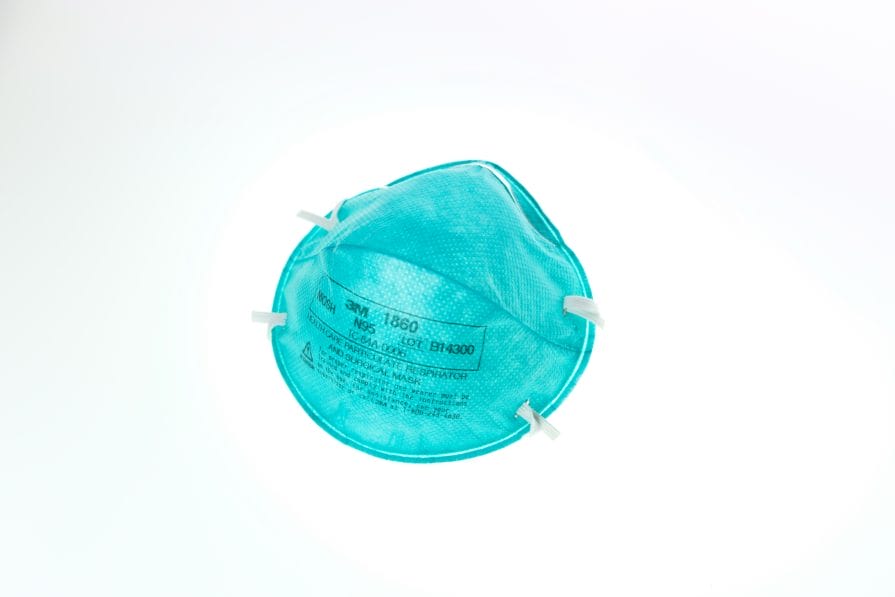
As the N95 mask gets clogged, it becomes more difficult to breathe. When this occurs, throw it out and use a new one. Discard the mask if it is wet or dirty on the inside, if it is deformed, or if the filter is torn. A deformed mask may not fit properly. An N95 mask cannot be cleaned or disinfected.¹²
Which Mask Rating is Best?
From the graph below, we can see the exact specifics of how each rating performs compared to the others.
There are a total of 6 different rating systems for masks, with each system being quite similar. The biggest difference is the region in which the rating system is certified. However, for the sake of this article, the P2 (Australia/New Zealand) and DS (Japanese) ratings aren’t important as those masks are generally less common.
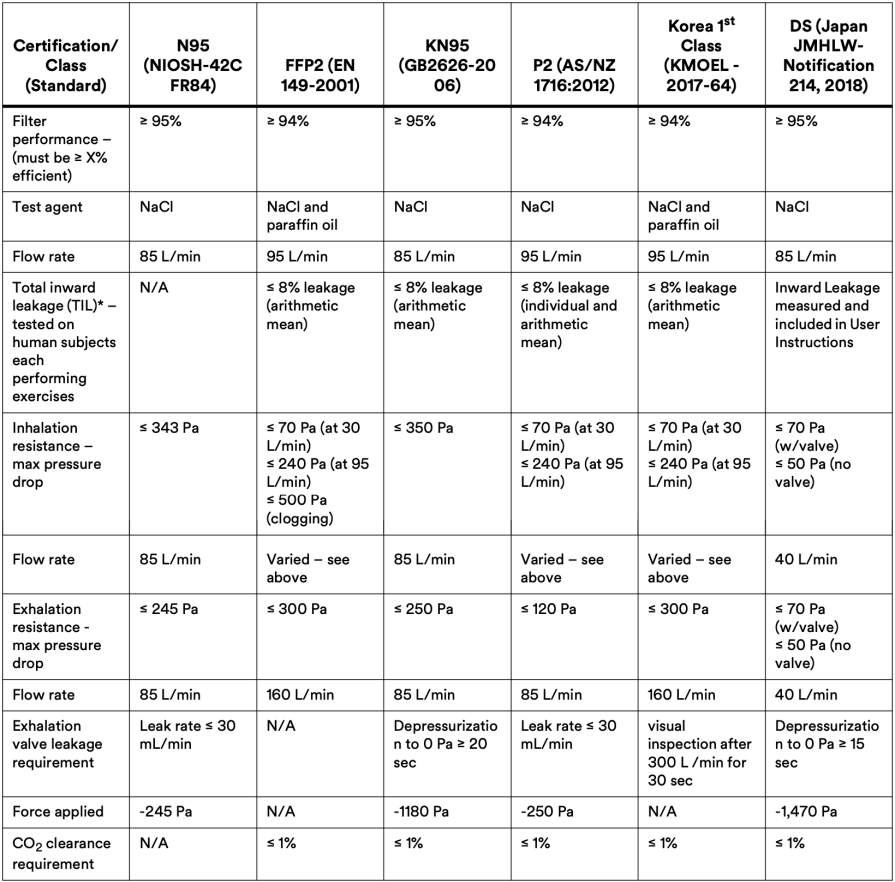
Graph from 3M’s Comparison of FFP2, KN95, and N95 and Other Filtering Facepiece Respirator Classes.
The above graph can seem quite overwhelming at first, however, the most important information is contained in the top row, ‘filter performance’. This shows the performance of the filtering in each mask, and as can be seen, every mask performs very similarly.
For this reason, the type of rating isn’t as important as the rating number. That is to say, an N95, KN95, and KF94 mask are all very similar in performance. What is more important, are the numbers (80, 94, 95, etc) as these represent filtration effectiveness.
Learn more about respirator ratings and what they mean.
N95 Masks
N95 masks are the most common and easiest to find masks in most countries. These masks are rated by the NIOSH and their effectiveness is well researched. While most of the mask ratings are very similar, N95 masks tend to be the most trusted as there is ample research available.
The NIOSH also certifies N masks as N99 and N100. These masks are rated to filter 99% and 99.97% of fine particles respectively. If you have to choose between an N rated mask and any other rating, pick the NIOSH rated mask.
R95 & P Masks
The NIOSH rates masks as N95, N99, N100, R95, and P95, P99, and P100. However, what do all of these different letters mean? The good news is that for those of us worried about fine dust, P and R rated masks are largely irrelevant.
An N95, P95 and R95 mask are all equal in the filtration capabilities. The same goes for N99 and P99, N100 and P100.
The significance of the letter is that it points to the mask’s oil resistance level. N masks are NOT resistant to oil, R masks are resistant, and P are oil proof.¹⁷ Therefore, when it comes to fine dust an N mask is usually all that is needed.
R masks might come in useful if you exercise near roads often. If you often find yourself biking behind vehicles, an R mask can come in handy due to the fumes being expelled from cars. P rated masks are only needed for those dealing with dangerous chemicals and oil-based aerosols.
KF94 Masks
KF rated masks are the most common fine-dust masks that you will find in South Korea. These masks are rated by the MFDS (Ministry of Food and Drug Safety) and come in two different variants. KF masks can either be found as KF80 of KF94, with these numbers representing the filtration efficiency.
KF94 masks perform only slightly behind the 95% rated masks (such as N95). The next section of this article compares KF ratings to N ratings and FFP ratings, and you can see that KF ratings perform the same as FFP ratings, and very similar to the comparable N rating.
KF Ratings vs N
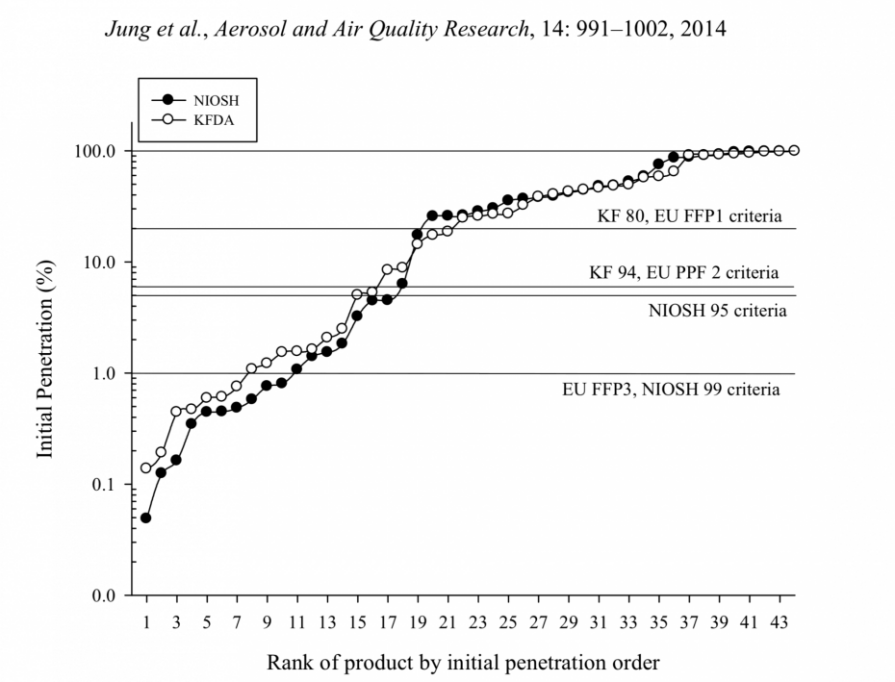
NIOSH (N) masks VS KFDA (KF masks). Hyejung Jung, Jongbo Kim, Seungju Lee, Jinho Lee, Jooyoun Kim, Perngjy Tsai, Chungsik Yoon. Comparison of Filtration Efficiency and Pressure Drop in Anti-Yellow Sand Masks, Quarantine Masks, Medical Masks, General Masks, and Handkerchiefs. 2014.
The NIOSH only certifies masks which surpass a rating of N95. No mask preventing less than 95% of fine dust particles will be given a rating. As such, you can be sure that you are getting a quality product if it has the N rating.
KF masks, on the other hand, are rated by KFDA (The Korean Ministry of Food and Drug Safety, now named the MFDS) and are unique to Korea. These masks are rated similarly to the NIOSH rated masks, with KF80 being the minimum rating.
However, with KF80 rated masks only preventing 80% of fine particulate matter from penetrating, it is recommended that you wear KF94, N95 or above.
When NIOSH and KFDA masks were compared to each other, both performed well. ‘All tested quarantine masks satisfied the maximum penetration criterion of 6% (KF 94)’.¹³
While similarly rated masks in both the KFDA and NIOSH systems perform similarly, it is noted that NIOSH masks perform better at higher ratings (N95+). Considering that KF ratings don’t surpass KF94, N rated masks are also capable of higher ratings and N99 should be used when possible.
How to Correctly Wear a Respirator
When putting on a respirator it is important to keep physical contact with the face-piece to a minimum. When touching the mask, try to restrict hand contact to the strings. Contact with moisture decreases the effectiveness of a mask, and oil and moisture from your hands can easily affect the usefulness of the material.
Holding the straps, pull the mask onto your head (or over your ears) with minimum contact to the mask itself. Adjust the wire nose-piece to make sure that it fits snugly and that there is no gap around your nose. Finally, perform air pressure checks to make sure that the mask isn’t leaking anywhere.
How to Make Sure the Mask Fits
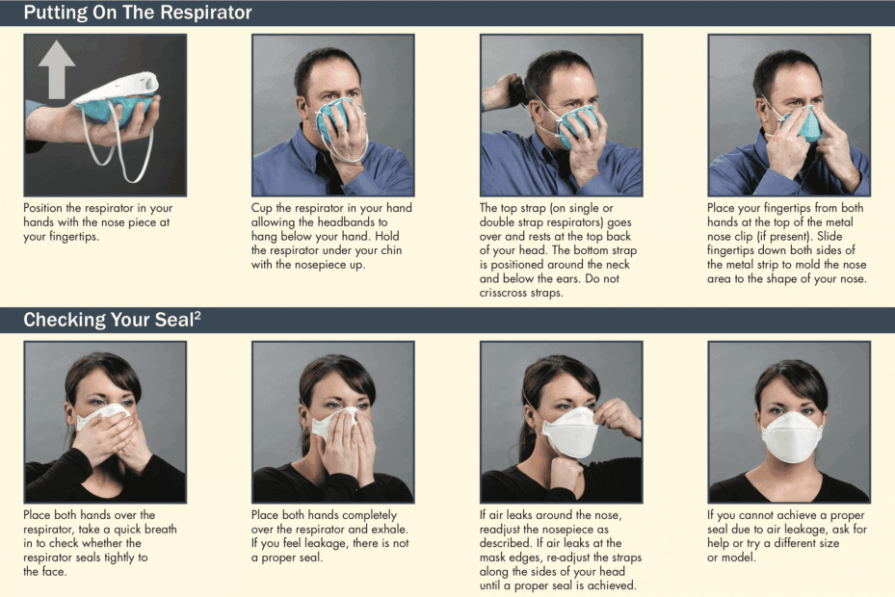
How to Properly Put on and Take off a Disposable Respirator.
Do a user seal check, including both positive and negative pressure checks, to verify that you have correctly put on the mask and adjusted it to fit properly.
- Negative pressure check. Place both hands completely over the mask and inhale sharply. Be careful not to disturb the position of the mask. The mask should pull into your face. If air leaks around your face or eyes, adjust the nosepiece and straps and repeat the positive pressure check.
- Positive pressure check. Put your hands over the mask and breathe out sharply. If your mask has an exhalation valve (like the one pictured above) be sure to cover the exhalation valve when you exhale. No air should leak out of the mask if it fits properly. If air leaks out, readjust the nosepiece and straps and repeat the negative pressure check.⁷
If both of the pressure checks succeed without air leakage, then the mask is protecting you from fine dust! If on the other hand, air leaks no matter what you try, consider purchasing a new mask in a different size.
It is worth mentioning though, that these masks aren’t designed for people with facial hair or for children. Children’s masks are available, but rarely are they as effective as adults masks. Facial hair will also reduce the effectiveness of respirators and there really is no other way around this except to remove the hair.

Again, I have to emphasise this. If you have any of the facial hair above (unless it has a green tick under it) then wearing a mask IS NOT effective. If you are concerned about your health, and want to wear a fine dust mask, make sure that your facial hair is fully contained within the mask and doesn’t touch the seal.
Which Korean Fine Dust Mask is Best?
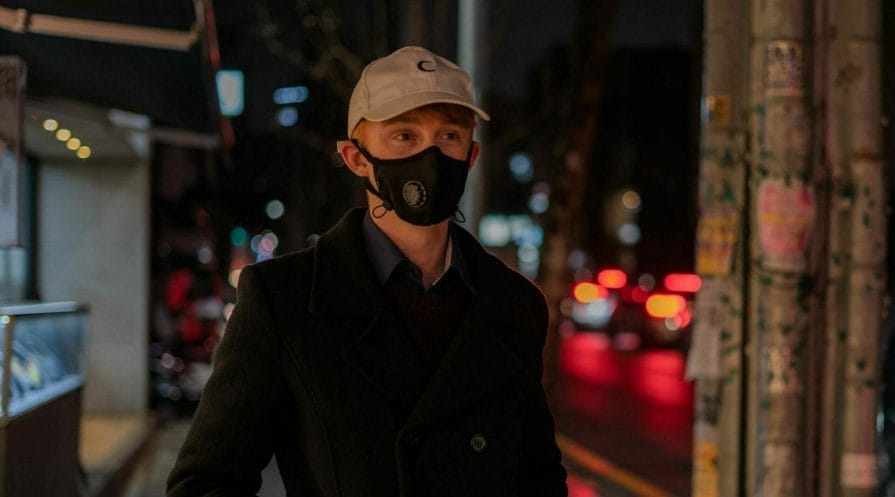
My personal mask preference is a reusable Cambridge Mask.
Unless you have a specific need for a moisture-resistant respirator, any mask of KF94 or N95 plus is very effective at stopping particulate matter from entering the respiratory system. N99 masks are of course better, however, they are also harder to find.
Some great N99 (or filtration equivalent) masks are the 3M 9332 and Cambridge Mask. However, please not that the Cambridge Mask is not officially rated N99. However, it does meet the filtration requirements.
Reusable Masks
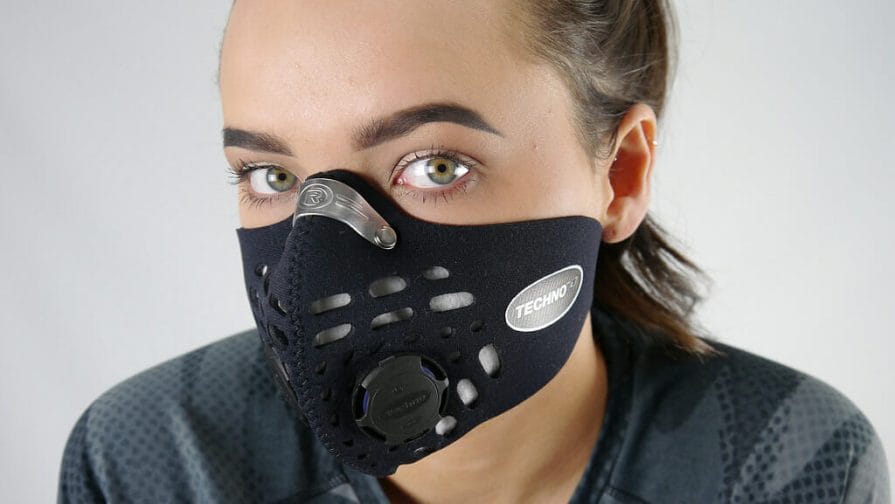
There are also masks available that can be used for longer periods of time. Masks such as the Cambridge ones last over 200 hours and are rated N99. These masks are more expensive than disposable ones, but for the extra length of use, they are often worth it.
There are many competitors out there such as Vogmask and Respro, and these masks are also highly regarded. While I have no affiliation with any of these companies, I personally use a Cambridge Mask and highly recommend it.
From my own research, I found it to be superior to Vogmask as it also prevents the penetration of 99.7% of bacteria and viruses.¹⁴
Cambridge Mask also had more extensive testing and as such, I tend to trust it more. Respro is an option that I didn’t look much into as the availability at the time of my purchase was limited. If you want a reusable mask, you can also check out the below brands:
Single-use Masks
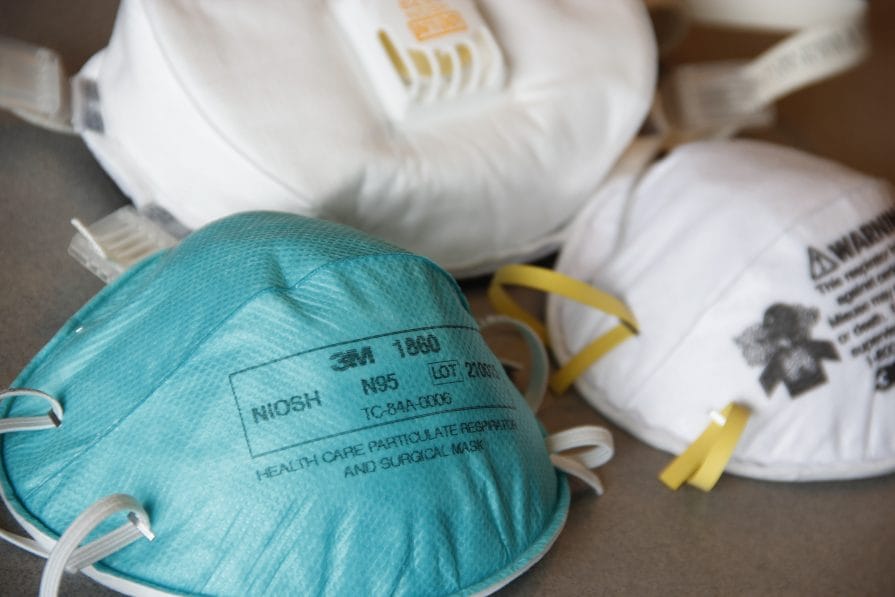
If you are not interested in reusable masks, then there are also many great disposable options available. While any mask with a NIOSH rating will perform well, there are many options available.
3M masks consistently perform well and are recommended by many. 10 packs of these masks can usually be purchased and these packs allow for a few weeks of use.
Many KF rated masks can also be found, and while these are still effective, most KF masks are only rated at 80. The best that KF has to offer is only KF94, and while 94 is still very effective, I feel far more comfortable knowing that I am wearing an N99 or N95 mask.
If a mask doesn’t have a KF or N rating, don’t even bother purchasing it. The other masks that are available are usually for bacteria, and they are made to prevent the spread of sicknesses. These masks will do very little to protect you and aren’t worth purchasing.
There are many other masks available, and many of them offer great dust protection. Really, the NIOSH and KFDA ratings are the keys to finding an effective mask. From there, it is a matter of finding the best fit for you.
To keep this article within a reasonable length, however, my broad recommendation is an N95+ rated 3M respirator. If you are looking for a reusable mask, then make sure to do research first and look at other reviews. It is important to find a mask that fits correctly and is comfortable.
Purchase fine dust respirators | Gearbest (KN95) | Ebay | Coupang
Learn More
It is important to always consider and monitor the air quality, or really anything, that can potentially harm your health. However, it can be hard to understand the AQI (Air Quality Index) readings and what they mean. To learn more, I recently wrote this post to help with everything there is to know about air quality in Seoul.
If you have any questions or comments about respirators, the air quality, or Seoul, please don’t hesitate to let me know. You can get in contact with me by leaving a comment below, or by contacting me here.
This post contains affiliate links that allow me to make money at no extra cost to you. I have no affiliation with Cambridge Masks, I am just a happy user of their product.
Sources
- https://www.aljazeera.com/news/2019/03/south-korea-plans-artificial-rain-reduce-seoul-air-pollution-190306095309023.html
- https://www.fijnstofmeter.com/documentatie/IQ-Fine%20Dust.pdf
- http://english.seoul.go.kr/policy-information/welfare-health-security/guide-measures-case-yellow-dust/
- https://www.theguardian.com/environment/ng-interactive/2019/may/17/air-pollution-may-be-damaging-every-organ-and-cell-in-the-body-finds-global-review
- https://www.nationalgeographic.com/environment/2019/08/air-pollution-linked-to-bipolar-disorder-depression/
- http://ijomeh.eu/Impact-of-air-pollution-on-depression-and-suicide,84931,0,2.html
- https://blissair.com/how-to-choose-right-mask-for-haze.htm
- https://ehs.msu.edu/occ/respirator/dustmask-vs-resp.html
- https://www.cdc.gov/niosh/npptl/topics/respirators/disp_part/default.html
- https://www.fda.gov/medical-devices/personal-protective-equipment-infection-control/masks-and-n95-respirators
- https://ehsdailyadvisor.blr.com/2018/04/dust-masks-reuse-toss/
- https://www.health.ny.gov/publications/2805/index.htm
- http://aaqr.org/files/article/668/36_AAQR-13-06-OA-0201_991-1002.pdf
- https://cambridgemask.com
- https://academic.oup.com/annweh/article/53/2/117/175361
- https://academic.oup.com/annweh/article/53/2/117/175361
- https://www.sfgate.com/california-wildfires/article/N95-P100-mask-respirator-camp-fire-explained-13399136.php
- https://multimedia.3m.com/mws/media/1791500O/comparison-ffp2-kn95-n95-filtering-facepiece-respirator-classes-tb.pdf
- https://www.mdpi.com/1660-4601/15/11/2565/htm#B76-ijerph-15-02565
How Can I Check Air Quality in Korea?
The AQI (Air Quality Index) is best checked using aqicn.org. While there are many different platforms out there that report on air quality, this website provides the most detailed breakdown on not only particulate matter but also on gases in the air.
f you are looking for a mobile app, then I recommend Air Quality. It is the most widely used and trusted app.
When Do I Need to Replace My Respirator?
As the N95 mask gets clogged, it becomes more difficult to breathe. When this occurs, throw it out and use a new one. Discard the mask if it is wet or dirty on the inside, if it is deformed, or if the filter is torn. A deformed mask may not fit properly. An N95 mask cannot be cleaned or disinfected.
Can I Re-Use a Respirator?
When it comes to fine dust, respirators can often be reused. For viral and bacterial protection, masks must be replaced every use. However, it is important that the mask is stored properly.
Store your mask in a place that is protected. Keep it out of sunlight, and make sure it stays dry. Make sure that it will not be crushed or deformed. Do not touch the filter of the mask. If possible, try to only touch the straps. Do not share your mask. Get separate masks for every family member.
Once the mask becomes difficult to breathe through, or gets deformed, replace it.
Can I Wear a Respirator With Facial Hair?
The short answer is no, you can’t. The longer answer is in some cases, yes, you can.
If your facial hair is fully contained within the respirator and does not interfere with the seal AT ALL, then it’s okay to wear a respirator with facial hair.
However, if you’r facial hair interferes with the seal in even the slightest, your protection will be limited.
Can I Use Convenience Store Masks?
Convenience stores will usually have surgical masks, dust masks, and respirators on sale. If you need to purchase a mask from a convenience store then make sure to purchase a mask with either an N or KF rating. N ratings are usually better, however, a respirator with a KF rating will also protect you.

Hi again, Do you have access to flu vaccines? or is the mask you wear enough of a prevention in picking up viruses, personally i would think so because viruses are also spread by hand to mouth. Are medications for your asthma very expensive?
And about masks, do you wear them at all times when outside? all year round, or is there a season when the pollution is lot less harmful?
I am unsure about the vaccines as I have never had to have them here. But in regards to the masks, yes, they are effective at preventing viruses. I could be wrong here (don’t quote me), but viruses attach to other particles and they spread via non-viral particles. As such, since an N99 mask prevents 99% of particles, it would also prevent 99% of the particles that viruses are attached to. The masks are also effective at preventing bacterial particles.
Luckily asthma medication is very cheap with NHI (National Health Insurance) and they are definitely cheaper than NZ. Although I can’t remember the specific cost right now.
About the masks – Me (and nearly all others) don’t wear them that often. If you follow the WHO guidelines the values considered dangerous are as follows:
PM2.5:
10 μg/m3 annual mean
25 μg/m3 24-hour mean
PM10:
20 μg/m3 annual mean
50 μg/m3 24-hour mean
However, nearly every day in Seoul is over these values. According to the WHO, 91% of the world’s population lives in dangerous air. While really masks should be worn every day, it is considered more of a relative risk. Since the air is always bad, masks are usually only worn on exceptionally bad days. I tend to wear mine whenever the AQI is over 120 (the average is about 70). These days happen maybe once or twice per month.
Interestingly, Spring brings the worst pollution. Due to the direction the winds blow in Spring, the air from China hits Korea and makes the air quality terrible. Otherwise, all of the other months can range greatly from day to day. Rain is great though, as it cleans the sky for the next day.
Thanks for all the info. I just bought a mask from gmarket and am unsure how long it’s supposed to last. http://item2.gmarket.co.kr/English/detailview/item.aspx?goodscode=1515880665#prw_list_link
Do you happen to know how long it will last and where I can find this information when making future mask purchases?
Hey Jayce. I am assuming that you purchased the reusable mask shown in the image, rather than the disposable masks?
If so, masks like this tend to last 200-300 hours. I am unsure on that mask specifically, but that seems to be the standard for reusable masks. The lifespan can be affected by a few factors but on a day of medium pollution in Seoul (AQI 100-150) it will last a couple of hundred hours at least.
The best way to tell is when breathing becomes difficult. Over time, you will notice that breathing becomes more difficult through the mask. This is a good indication of when you will need to replace it.
Unfortunately finding information on each mask can be very difficult (especially for Korean brands). That’s why I talked about Cambridge mask and Vogmask in the post. While there are lots of great dust-masks out there, these two brands provide the most clear information. Cambridge masks last 300 hours in medium pollution (https://cambridgemask.com/frequently-asked-questions/), and Vogmask advertises their masks as lasting for 4-5 months (https://www.vogmask-europe.com/pages/faq-health-protection-pm2-5-air-pollution-breathing-dust-mask).
Unfortunately, these masks tend to carry a premium compared to Korean brands/unbranded masks. I did find an option on Coupang for 25,000KRW though which isn’t too much more than the mask you mentioned.
I hope this helps you! If you have any further questions please feel free to ask.
Just to let you know – both Cambridge Mask and Vogmask are not approved by NIOSH. Their supposed “N95” and “N99” ratings for their masks are not NIOSH-certified. Vogmask has been blacklisted by the CDC (https://www.cdc.gov/niosh/npptl/usernotices/counterfeitResp.html) and Cambridge Mask has been directed by NIOSH / the CDC to remove their false representations of the N-rating in relation to NIOSH, on the understanding that if they did not, they would also be publicly blacklisted. (This is why the Cambridge Mask website has, over the past few days or so, been removing all N95, N99 and NIOSH references.)
It may be that both companies make masks that are better than the average cloth mask out there. However, both companies have been making false representations about their products to the public for years. This has finally caught up to them due to increased scrutiny from NIOSH and the larger CDC, given the current pandemic.
Cambridge Mask continues to privately dispute consumers’ attempts to ask about these false representations – they are still claiming N99 standards in private correspondence with consumers. Many customers are having difficulty dealing with the company in this situation. Would not recommend either company’s masks in this context.
Hello Jas. I became aware of this issue a few days ago and have changed the wording on my post to reflect it. While you are right about what the CDC has said, and that these masks don’t hold NIOSH ratings, there are some other factors to be aware of.
Vogmask was blacklisted for claiming to have the N95 certification when in reality, it only met the filtration requirements of the N95 standard. Cambridge Mask is now having the same issues.
That is to say, these masks don’t hold NIOSH ratings due to the nature of the mask. Consumer-grade reusable respirators can’t get NIOSH certification. However, they still (if fitted correctly) can provide filtration of fine particles similar to the same efficiency as N95 and N99 rated masks. I have seen the lab test results of both companies, and both filter respective to their claims (N95 and N99).
The wording and advertising that they used is unacceptable. If they ever indicated that they were rated by the NIOSH when they weren’t (I know Vogmask did, I am unsure about Cambridge Mask), then I am happy that the CDC is acting.
However, it is true that these masks are both far superior to a cloth mask. They do (to my knowledge) still officially hold other ratings such as KF94 and KN95 which do put them firmly above many other masks on the market.
Thank you for your comment! I have updated my post to reflect that they don’t hold NIOSH ratings but rather only adhere to the filtration requirements.
I love your article so much. But I have a question which type of mask is better to protect us from coronavirus: reusable masks or single-use masks? Thanks!
I decided to buy N95 masks a few days ago and I’m quite satisfied with them, very comfortable and breathable. I hope they could effectively protect us from coronavirus.
Which N95 masks did you purchase? I’m looking for some that are comfortable but have yet to find some that I like!